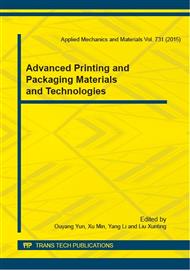p.340
p.345
p.351
p.355
p.360
p.365
p.369
p.374
p.381
Effect of ClO2 Controlled Release Packaging on the Preservation Performance of Oilseed Rape
Abstract:
In order to extend the shelf life of vegetable at room temperature (25±1°C) and lower the decay losses in storage and circulation sales, we studied a kind of three-layer packaging material which could release ClO2. The effects on shelf life of two kinds of preservation packaging were comparatively investigated: ClO2 controlled release packaging and ordinary preservation film with ClO2 sterilization labels, the Oilseed rape packaged with ordinary preservation films as the control group. During the experiment, the headspace concentrations, appearance quality, Total soluble solids (TSS), Titratable acid (TA), and the Vitamin C (VC) content were tested and analyzed every day. The experimental results showed that ClO2 controlled release packaging could form a suited modified atmosphere packaging (MAP) environment and prohibit the growth of microorganism. After 5 days’ storage, the leave of oilseed rape in control group turned yellow and wilted. While the oilseed rape in ClO2 controlled release bags was still fresh and green. The appearance and taste of the oilseed rape in ClO2 controlled release bags still had commercial values. Therefore, the preservation effects were obvious.
Info:
Periodical:
Pages:
360-364
Citation:
Online since:
January 2015
Authors:
Keywords:
Price:
Сopyright:
© 2015 Trans Tech Publications Ltd. All Rights Reserved
Share:
Citation:


